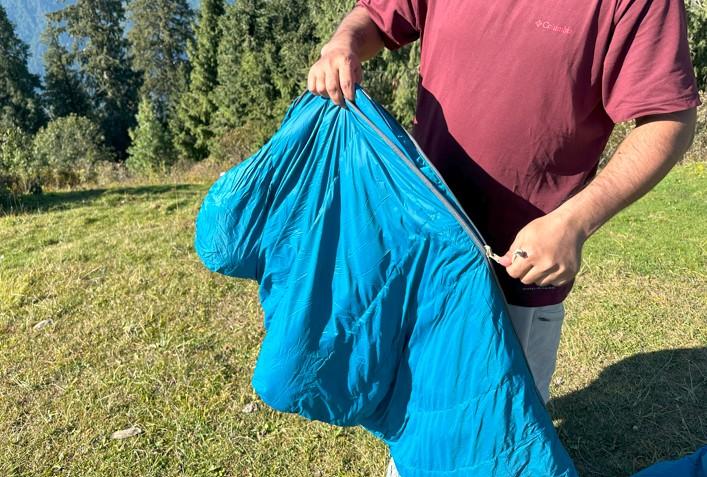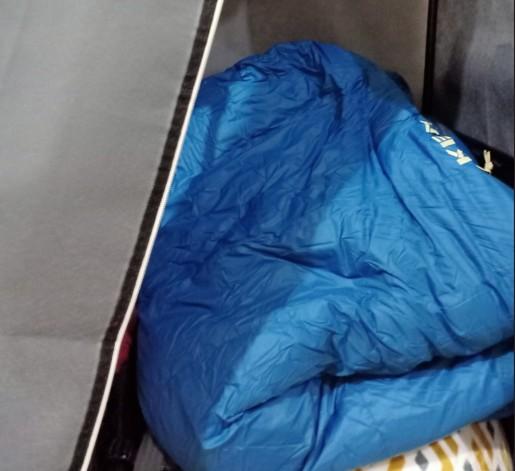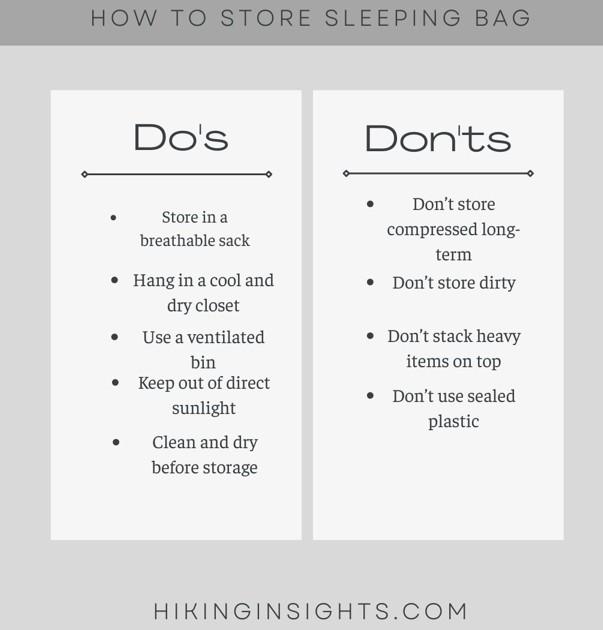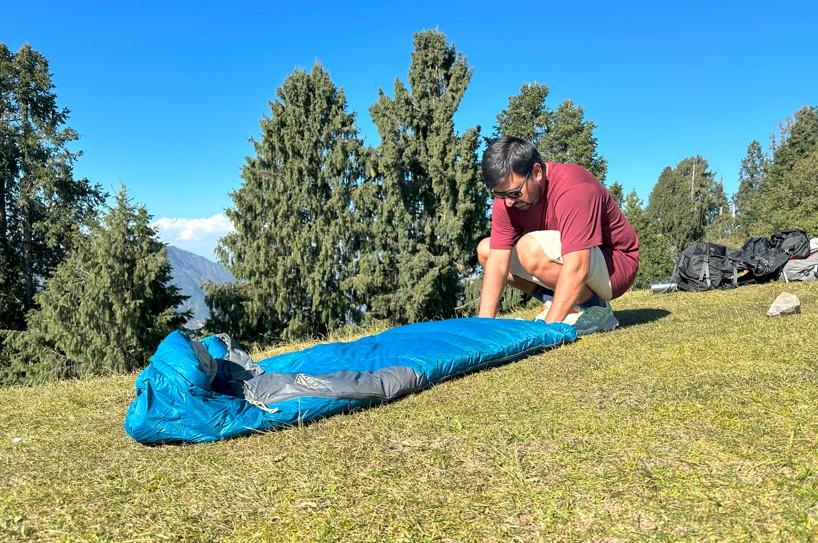Don’t ruin your expensive sleeping bag like I did in the beginning, due to lack of knowledge and experience. I packed it inside the compression sack and stored it in my luggage for a year. You know what happened? My sleeping bag lost its loft and warmth—and I lost money. Properly storing your sleeping bag isn’t just a good idea—it’s essential if you want to preserve the loft, warmth, and performance you paid for.
We’ve spent years testing bags in the field and poring over specs from every top brand out there, and if there’s one takeaway, it’s this: how you store your bag when it’s off-trail has just as much impact on its longevity as how you use it on-trail.
Whether it’s a premium model or a budget sleeping bag, compressing your bag too long can shorten its lifespan. In this guide, we’ll break down best practices for storing your sleeping bag, explain why material type matters, and share exactly what not to do—pulled from real-world use and years of hands-on testing.
Understand Your Sleeping Bag Material
Down or synthetic? It matters more than you might think. Down insulation—known for its warmth-to-weight ratio and compressibility—is also sensitive to moisture. Leave it packed up wet, and you’re risking mildew, clumping, and a serious loss of loft.
Synthetic bags tend to be a bit more forgiving in terms of care, but even they perform best with proper airflow and zero compression in storage.

We’ve found that shell fabrics like ripstop nylon and polyester can also influence how well your bag breathes. If your bag doesn’t vent well, storing it in a humid garage or attic is asking for trouble. Your best bet? A breathable mesh storage sack or ventilated bin in a dry, climate-controlled space.
Our sleeping bag storage method applies to almost all kinds of bags. But also check the manufacturer’s care tag if it’s still there. Some high-end bags may have specific recommendations based on the fabric or insulation blends.
Cleaning Before Storage
Dirt, sweat, and body oils can do a number on your bag’s insulation over time, whether it’s down or synthetic. Before you store your bag, give it a clean.
For down bags, don’t wash with the harsh detergents. Take special down cleaner or gentle, non-detergent soap. For my down sleeping bag, I use Dr. Bronner’s Castile Soap, which is also nature-friendly. Always dry thoroughly—residual moisture is the enemy.
Best Storage Methods for Sleeping Bags
Hanging Your Sleeping Bag
Hanging is our top choice for long-term storage. Use a hanger with wide, padded shoulders (avoid thin wire ones that can stress the fabric), and hang your bag in a cool, dry closet.
We’ve had testers hang their Kelty Cosmic Down 20 bag for years with no loss of loft—just be sure to avoid sunlight and keep dust off with a breathable sack.
Storing in a Large Drawer or Shelf
If closet space is tight, a clean, breathable drawer or open shelf can work. Fold the bag loosely for storing. For storage, we suggest you fold the bag lightly in a breathable storage container, preferably made of cotton or mesh.
Plastic bags are not preferable for sleeping bags because they trap moisture and cause mold. This method is better for short-term storage; however, you must not stack heavy items on top of it to prevent damage to its composition.

We’ve seen bags stored this way for a full season and bounce back perfectly fine—just make sure airflow isn’t blocked and you’re not using a sealed plastic bin.
Using a Storage Sack or Bag
Most high-quality bags come with an large cotton or mesh storage sack—and for good reason. These mesh sacks allow better airflow while maintaining bag loft.
For best storage, we suggest storing your bag in a spacious, breathable area, like a large cotton or mesh storage sack. This storage method prevents mold growth and preserves the bag’s insulation.

Additionally, these sacks retain the shape and fabric of the bag and help preserve it for long-term use. I have tested a DIY pillowcase as well to store the bag, and it worked well. If you want to try the pillowcase method, make sure it’s breathable and spacious.
Ventilated Storage Bin
If you must use a bin, go with a ventilated one. While people normally store sleeping bags in garages, basements, and attics, these are the places that can reduce their longevity.
The best practice is to toss in some silica gel packs and store the bag in a temperature-controlled room.
Tips for Long-Term Storage
Keep in a Cool, Dry Place
How to store a sleeping bag for long-term usage is a question often asked. From our experience, we suggest you store it in a climate-controlled space and never in garages and basements.
For enhanced safety, packs of silica gel work best. In case storing the bag in a garage is unavoidable, place the bags in ventilated bins to avoid moisture and to check humidity levels. As discussed above, packs of silica gel are essential for combating moisture.
Additionally, shield the bags from direct sunlight as well to avoid fabric degradation.
Avoid Compression for Storage
Compression sacks are great for the trail—not the closet. The sleeping bags are made of puffy material, and continuous pressure on top may compress their material. We tell them to avoid compression and stacking on top of the sleeping bags.
Never store bags in compressed compartments, as it damages insulation over time. We’ve seen it happen with both budget and premium bags. So, give your insulation bags room to breathe.
Regular Inspection
Even in storage, don’t store and forget your sleeping bag. Every few months, pull it out, give it a fluff, and look for any signs of mold or fabric degradation.
One of our testers rotates his stored bags every six months—a habit we recommend. It keeps the fill evenly distributed and lets you catch any issues early.
Unused sleeping bags may create odor and keep dust; it is crucial to air the bags periodically.
What Not to Do
Here’s the short list of cardinal sins we’ve learned the hard way:

- Don’t store your bag compressed long-term.
- Don’t use sealed plastic bins or garbage bags.
- Avoid basements, garages, and attics unless climate-controlled.
- Never pack away a dirty or damp bag.
- Keep it out of direct sunlight.
- Don’t stack heavy gear on top of your bag in storage.
Conclusion
A sleeping bag is an essential component for a hiker. Proper storage improves its life, warmth, loft, and quality. The performance of your sleeping bag depends on the care you provide. It is important to tailor the methods of preservation to the insulation type of your sleeping bag.
The down insulation needs airflow to a larger extent, while synthetics can tolerate compression to some extent. For higher efficiency, use breathable mesh storage sacks. Even if you store it in a dry place, add some silica packs and check it regularly for any unnatural damage. In the long run, it saves time, sleeping bags, and money.
